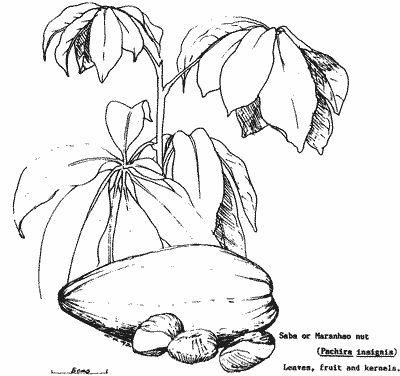
THE SABA NUT I
SCIENTIFIC NAME: Pachira aquatica
FAMILY: Malvaceae
Saba Nut, also known as Guyana Chestnut, is a popular South American nut. It has a thin-skinned, 20mm long kernel borne in 7- 10cm-long, easy-opening pods of about 20 kernels. The tree bears very heavy crops beginning about the fifth year, by which time it may be seven metres tall. The white nuts, which consist of folded cotyledons, have a smooth and soft texture. They are great to eat raw or stir fried with vegetables, or they may be fried, boiled or roasted and eaten like other nuts. The tree is extremely adaptable, growing in either a dry or wet tropical environment, and needs little care.
Because the seeds germinate readily on the ground under the tree, it is recommended that the pods be picked when mature, or harvested as they fall. Ripening in February.
The root system is very vigorous and strong, perhaps exceeding in growth the above-ground portion of the tree. The main roots of the tree I observed, which were green, and therefore photosynthesising like the leaves, were bursting out of the ground, each root as large as the bole of the tree.
Saba nut is cultivated all over the tropical world for its delicious seeds. In Hawaii, it is sometimes known as Malabar Chestnut. In Central America, it is called the Provision Tree. The tree has been introduced into Tahiti and Mexico. In Angola, southern Africa, it is seen in backyards. In Zaire, it has been grown commercially, although to what extent is not known.
An Angolan writer says: "When the large fruits are ripe they split open and discharge their many nuts to the ground. If there are showers, they will sprout on the surface of the soil. Without rains they will sun-dry, or must be protected from moisture until dried in the sun."
One author, Sturtevant, says: "When roasted, they taste like chestnuts. The young leaves and flowers are used as a vegetable. There is nothing better than this chestnut cooked with a little salt."
The following is from Celestino Pesce's Oil Palms and Other Oilseeds of the Amazon: Saba or Maranhao nut (Pachira insignis) Leaves, fruit and kernels. "Commonly called 'Mamorana' in Brazil, Saba is a tree of medium size with large branches. It occurs along riverbanks and lagoons throughout the Amazon basin, the Upper Orinoco and in the Guianas. Commonly cultivated as an ornamental tree, it can be found growing well in parks and along avenues of several of the state capitals of the Brazilian northeast where it is popularly called 'Munguba'. It is also a common park tree in Rio de Janeiro (in Brazil's subtropical south). The Saba nut grows much larger on upland sites than it does on the wet sites of the Amazon. I recall seeing a very large mamorana tree, which must have been quite old in the city of Forteleza (in the northeast of Brazil).

"Saba nut flowers are very large and its fruit is nearly the size of the cupuassu. The fruit is a large, ovoid, dehiscent capsule 15-20cm in length and 12-14cm in diameter. It has a velvety, rough skin which is a rusty-red colour and marked with deep, longitudinal grooves at the junctures of the various segments which make up the fruit. When the fruit is mature, the segments of the capsule open, allowing the seeds to fall to the ground.
"A single fruit contains about 40 seeds. While these are closely packed, a thin membrane separates them individually. The seed has a flexible, light brown shell which resembles a bean. The kernel consists of a thick leaf, rolled into an irregular shape which is nearly square.
"Saba seeds are edible after being cooked and taste like chestnuts. Seeds falling into water are consumed by fish and turtles. The seeds contain 30% moisture, are oily and when dry weigh an average of 5g. They are composed of 10% shell and 90% kernel. The kernel contains 56-58% fat.
At the ambient temperature of the tropics, (the extracted fat) has the consistency of petroleum jelly, is white in colour and edible with a pleasant odour faintly redolent of licorice. The fat (which has industrial potential) can be used in making soap, but would be better utilised if it were refined into an edible product."
Pesce provides an analysis of the oil - it is low in fatty acids and has an initial melting point of 31°C.
According to F.C. Hoehne, "The seeds of many species of the Bombax family are rich in oil which is edible. The Pachira insignis is a species which could and should be considered a fruit, because it produces seed contained in capsules which are commonly called Maranhao Nut." A local grower has this tree fruiting, and the nuts, which are larger than those of the Saba nut, taste just as good as that nut. The tree is quite similar, (see illustration). The young leaves and flowers are reputed to be edible also. There is another species, Pachira grandiflora, from the West Indies. The seeds are eaten as chestnuts are.
References:
1. Edible nuts of the World, by Edwin A Menninger, 1977, publ. Horticultural Books, Inc., Box 107 Stuart, Florida, 33494, USA.
2. Oil Palms and Other Oilseeds of the Amazon, by Celestino Pesce, 1941, translation by Dennis V. Johnson, publ. 1985 by Reference Publication, Inc., Box 344, Algonac, Michigan, 48001, USA.
DATE: November 1992
* * * * * * * * * * * * *
